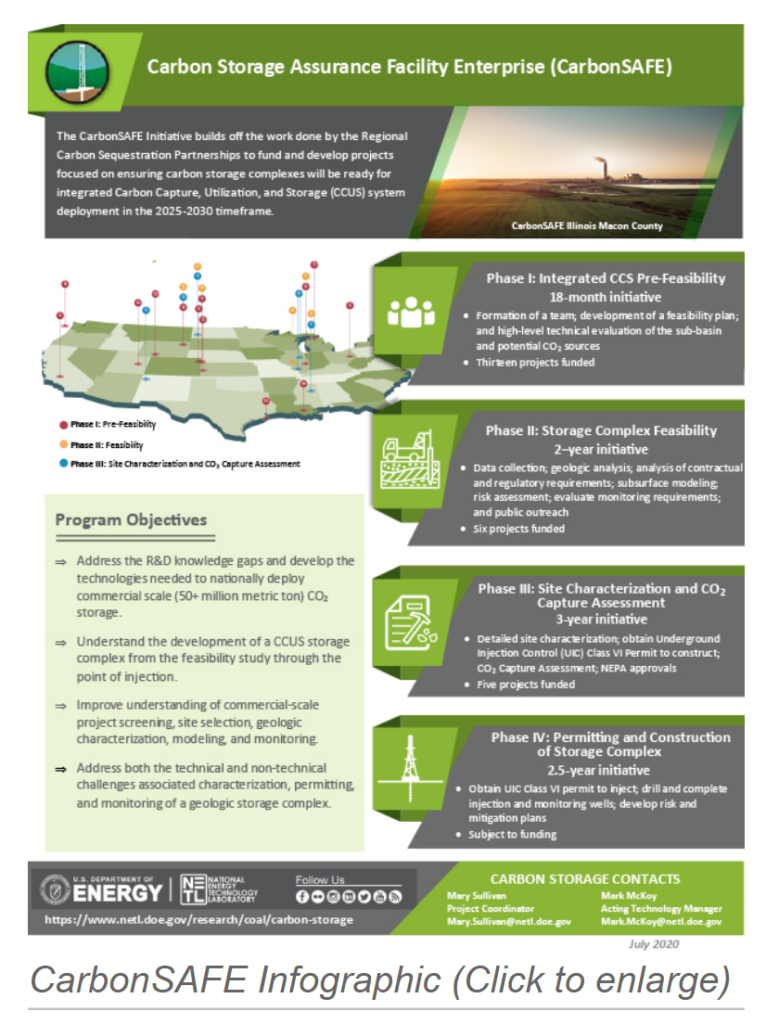CarbonSAFE Initiative
The Carbon Storage Assurance Facility Enterprise (CarbonSAFE) initiative, supported by the Department of Energy (DOE) and the National Energy Technology Laboratory (NETL), began in 2016 with the goal of expanding CCS deployment accross the U.S. Building upon the knowledge and experience of the Regional Carbon Sequestration Partnerships’ (RCSPs’), such as CUSP, this initiative is performing identification and detailed characterization of geologic storage sites.
The CarbonSAFE Initiative supports CCS projects from the feasibility study until the point of injection through the following phases:
- Phase I: Integrated Pre-Feasibility Projects
- Phase II: Storage Complex Feasibility Projects
- Phase III: Site Characterization and Permitting
- Phase IV: Construction
To learn more about the different Phases visit NETL CarbonSAFE overview or contact us to be involved and/or apply to be part of a CarbonSAFE project.
All active CarbonSAFE projects and publications can be found at the following link:
The CUSP Supports CarbonSAFE Initiatives
Many CUSP partners are collaborating to develop CarbonSAFE Initiatives over the Western U.S.
The CUSP team can help you to develop your CCS/CCUS project through the CarbonSAFE Initiative.
CarbonSAFE projects in the CUSP region:
San Juan Basin CarbonSAFE Phase III: Ensuring Safe Subsurface Storage of CO2 in Saline Reservoirs.
Get more information here:
- Website
- Webinar link
- Project outreach presentations
- San Juan Basin CarbonSAFE Phase III: Ensuring Safe Subsurface Storage of CO2 in Saline Reservoirs,
Integrated CCUS Projects and FEED Studies, August 2, 2021.
Front End Engineering Design Study for Retrofit Post-Combustion Carbon Capture on a Natural Gas Combined Cycle Power Plant – Fluor’s amine-based Ecoamine FG Plus
Get more information here:
Integrated Midcontinent stacked Carbon Storage Hub Storage Complex feasibility assessment
Commercial-Scale Carbon Storage Complex Feasibility Study at Dry Fork Station, Wyoming
- Website – UW
- Final Report
- Wyoming CarbonSAFE: advancing commercialization of low-carbon energy technologies in fossil-rich Wyoming,
15th International Conference on Greenhouse Gas Control Technologies, March 15, 2021.
Integrated Pre-Feasibility Study for CO2 Geologic Storage in the Cascadia Basin, Offshore Washington State and British Columbia
California CO2 Storage Assurance Facility Enterprise (C2SAFE)
CarbonSAFE Rocky Mountains Phase I: Ensuring Safe Subsurface Storage of CO2 in the Intermountain West
Integrated CCS for Kansas (ICKan)
Integrated CCS Pre-Feasibility in the Northwest Gulf of Mexico
CarbonSAFE Initiative
Here’s a more detailed explanation of CarbonSAFE:
1. Purpose and Goal: The primary purpose of CarbonSAFE is to accelerate the development and deployment of carbon capture and storage (CCS) technologies. Its overarching goal is to ensure the safe, long-term storage of CO2 emissions from industrial facilities, power plants, and other sources, thereby helping to reduce greenhouse gas emissions and combat climate change.
2. Project Development: CarbonSAFE projects involve comprehensive research, assessment, and planning to identify suitable geological formations for CO2 storage. These formations typically include depleted oil and gas reservoirs, saline aquifers, and other subsurface structures. Geologists, geophysicists, and engineers play a crucial role in evaluating these sites.
3. Risk Assessment: A key aspect of CarbonSAFE projects is to conduct thorough risk assessments to ensure that the chosen storage sites are both technically and environmentally suitable. This includes evaluating the potential for CO2 leakage, monitoring the geological integrity of the storage formations, and assessing any potential impacts on groundwater and surface ecosystems.
4. Regulatory Compliance: CarbonSAFE projects adhere to strict regulatory guidelines and compliance requirements set by federal and state agencies to ensure the safe storage of CO2. This includes obtaining permits and approvals for site characterization, injection operations, and ongoing monitoring.
5. Stakeholder Engagement: CarbonSAFE projects often involve engagement with local communities, landowners, and other stakeholders to address concerns, share information, and ensure transparency throughout the project lifecycle.
6. Technological Innovation: CarbonSAFE also encourages the development of innovative technologies and techniques for CO2 capture, transport, and storage. This includes advancements in carbon capture equipment, monitoring systems, and injection methods to improve the efficiency and cost-effectiveness of CCS.
7. Public and Private Collaboration: Many CarbonSAFE projects involve partnerships between government agencies, research institutions, industry stakeholders, and private companies. These collaborations leverage expertise, funding, and resources to advance CCS technology.
8. Carbon Reduction Benefits: Successful CarbonSAFE projects contribute to a significant reduction in CO2 emissions by capturing and storing large volumes of CO2 that would otherwise be released into the atmosphere. This reduction aligns with national and global climate goals.
In summary, CarbonSAFE is a vital initiative that plays a critical role in the development and deployment of carbon capture and storage technologies, ultimately contributing to the reduction of greenhouse gas emissions and the fight against climate change. It combines scientific research, regulatory compliance, technological innovation, and stakeholder engagement to ensure the safe and responsible storage of CO2 emissions in geological formations. By addressing the challenges associated with carbon storage, CarbonSAFE helps pave the way for a more sustainable and environmentally responsible future.


